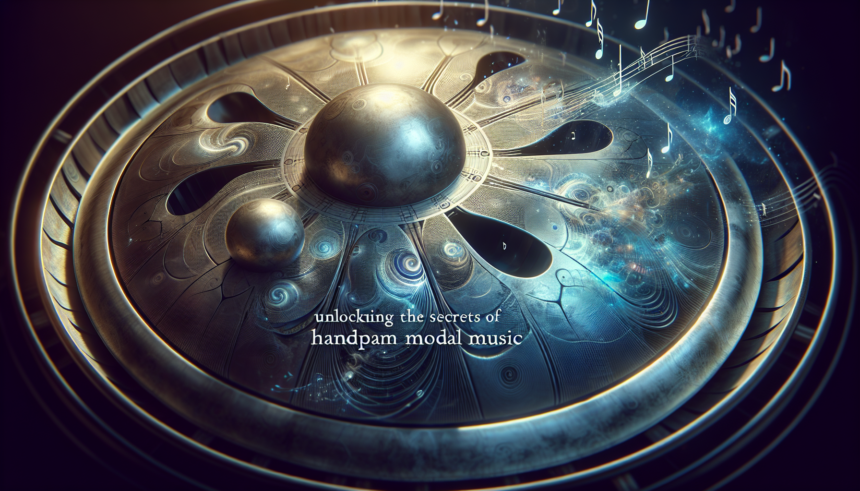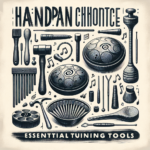Handpans, also known as pantams, have grown immensely popular since their inception in the early 21st century. These unique, UFO-shaped instruments create ethereal, meditative sounds that captivate the listener. Understanding the modal structure of handpan music is key to unlocking its expressive potential and appreciating its intricate beauty. This article delves into the secrets of handpan modal music, exploring its origin, modal principles, and practical applications.
Origins of the Handpan
The handpan was first created in Switzerland by Felix Rohner and Sabina Schärer, the co-founders of PANArt. Introduced as the Hang in 2000, this instrument was inspired by various steel instruments like Trinidad’s steel drums and the Indian ghatam. The design and acoustics of the handpan were meticulously crafted, resulting in a percussion instrument that offered melodic capabilities and a deeply resonant sound. Other manufacturers soon followed suit, adding their unique touches and creating a variety of handpans available today, further expanding its sonic possibilities.
The Structure of Handpan Music
Handpan music is based on a modal system, which is integral to its distinctive sound. Unlike the Western music scale system that moves step-wise in whole and half steps, a modal system is defined by unique sequences of intervals within an octave. Depending on the number of notes, handpans can be tuned to various modes, each offering a distinct emotional and auditory landscape.
To understand modal structures, it’s essential to clarify what modes are. In musical terms, a mode is a type of scale coupled with a set of characteristic melodic behaviors. Apart from the common Major (Ionian) and Minor (Aeolian) scales, there are several other modes like Dorian, Phrygian, Lydian, Mixolydian, and Locrian, each with its unique flavor.
Common Modes in Handpan Music
Handpans can be tuned to any mode, although certain modes are more commonly used due to their emotional resonance and ease of use. Here are a few popular modes:
Dorian Mode
The Dorian mode is recognized for its balanced and versatile sound. It feels minor but lacks the ‘mournfulness’ often associated with minor scales. The sequence is as follows: Root, Major 2nd, Minor 3rd, Perfect 4th, Perfect 5th, Major 6th, and Minor 7th. Dorian can evoke a sense of contemplation and emergent hope, making it a popular choice among handpan players.
Phrygian Mode
The Phrygian mode carries an exotic, somewhat dark and mystical quality. Its sequence consists of: Root, Minor 2nd, Minor 3rd, Perfect 4th, Perfect 5th, Minor 6th, and Minor 7th. Known for its flamenco-like and Middle Eastern sound characteristics, it can generate a raw and intense musical atmosphere.
Mixolydian Mode
The Mixolydian mode yields a bright, major sound but with an inherent ‘bluesy’ twist due to its lowered seventh degree. The sequence is: Root, Major 2nd, Major 3rd, Perfect 4th, Perfect 5th, Major 6th, Minor 7th. Its joyous yet grounded sonic quality is suitable for genres ranging from jazz to folk.
Other Modes
While the previously mentioned modes are widely used, handpan players often experiment with other exotic and lesser-known modes to expand their musical horizons. These could include modes derived from non-Western music systems, enriching the handpan landscape even further.
Practical Application: Playing in Modes
To effectively harness the power of modal handpan music, a player should practice the following techniques:
Scale Practice
Mastering the scales of various modes on a handpan is fundamental. Players should start by practicing one-octave patterns, gradually expanding to more complex phrases that utilize the whole instrument. This will help in internalizing the unique intervals and embellishments characteristic of each mode.
Chordal Exploration
Each mode allows for different harmonic possibilities. For example, in Dorian mode, the i minor chord, iv minor chord, and V Major chord are commonly used. Exploring chord voicings within a mode will enhance a player’s ability to accompany melodies and create lush, harmonic landscapes.
Melodic Improvisation
One of the profound joys of playing the handpan is the ability to improvise. Modal improvisation helps players build spontaneous melodies that are rich and coherent. This involves deeply listening to the sound and feel of each note and how it transitions to others within the mode.
Dynamics and Articulation
The expressive potential of handpan music is also tied to dynamics (loud or soft playing) and articulation (the way notes are started and ended). Varying these elements within a modal framework will add emotional depth and variety to performances.
Conclusion
Understanding and exploring the modal structures in handpan music reveals a universe of sonic possibilities. These modes, ranging from the contemplative Dorian to the intense Phrygian, enable players to express a wide emotional palette. Coupled with techniques like scale practice, chordal exploration, and dynamic improvisation, mastery of modal handpan music allows musicians to create deeply resonant and transcendent musical experiences. As more artists delve into this mesmerizing world, the handpan continues to evolve, captivating audiences and enhancing the landscape of contemporary music.
Frequently Asked Questions (FAQs)
1. What is the difference between a handpan and a traditional drum?
Unlike traditional drums that are primarily rhythmic, the handpan is both rhythmic and melodic. It comprises a series of tuned notes arranged in a circle around the central note, known as the “ding,” allowing for harmonic and melodic play as well as percussive rhythms.
2. Can a handpan be tuned to any mode?
Yes, handpans can be tuned to a variety of modes, making them versatile instruments. However, the specific tuning depends on the manufacturer’s design and intent. Some modes are more common and frequently requested due to their musicality and ease of use.
3. How do I choose the right mode for my handpan?
Choosing the right mode depends on your musical goals and emotional resonance with the sound. Listening to different modes and observing which one evokes the desired emotional landscape is a good starting point. Consulting with experienced players or manufacturers can also help in making this decision.
4. Is it difficult to learn handpan music?
While learning any musical instrument has its challenges, the handpan is generally considered accessible due to its intuitive layout and pleasing sound even for beginners. Regular practice and familiarity with musical scales and modes will aid significantly in the learning process.
5. Where can I learn more about handpan modal music?
There are numerous resources available for learning more about handpan modal music. Online tutorials, instructional books, forums, and workshops offered by experienced players and educators are excellent ways to deepen understanding and improve technique.





